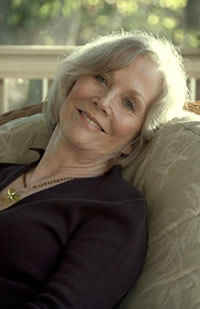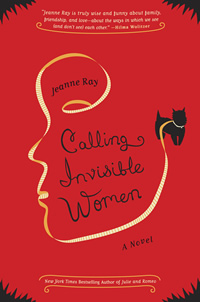Can You See Me Now?
With her fifth and most ambitious novel, novelist Jeanne Ray has written a marvelous meditation on middle-aged obscurity
Fifty-four-year-old Ohio housewife Clover Hobart is happily married to husband Arthur, a successful pediatrician, and is the loving mother of Evie, a cheerleader at Ohio State, and Nick, a recent college graduate once again living at home during a fruitless job search. A former newspaper reporter, Clover has been downsized to writing a weekly gardening column. With Arthur’s heavy work load and the kids more or less on their own, she passes the time by walking her Cairn terrier, Red; having coffee with her best friend, Gilda; and taking yoga classes taught by Arthur’s free-spirited (and surprisingly limber) seventy-six-year-old mother, Irene. Life is proceeding more or less uneventfully until the morning Clover steps out of the shower and fails to see her reflection in the bathroom mirror. As with Claude Rains in The Invisible Man, her clothing (in this case, her bathrobe) is still visible, but her body has simply vanished.
Before Clover can begin to comprehend what has happened to her, she temporarily reappears. Staring at herself in the mirror, she indulges in a pastime common among middle-aged women: “Soon my worry about invisibility had been replaced by a cataloguing of flaws: my eyelids were drooping in a weird way that made my entire face look asymmetrical, and the crease between my eyebrows made me look as if I had been struck in the forehead by a very small ax. And my mouth! Where had my lips disappeared to over the years?” These vexations are soon rendered moot, however, as Clover wakes up the next day invisible once again. As she waits to reappear, she has a horrible thought: “What if I had been flickering in and out for a while now—in my sleep or in the car or in the kitchen chopping vegetables? It had been years since I’d really kept an eye on myself.” As she fears, this time the change seems more or less permanent.
 As she considers and rejects various hypotheses—cerebral hemorrhage, partial blindness, mental illness—she is amazed by the number of people around her who simply do not notice any difference. After Gilda verifies that it is possible for others to perceive her invisibility, Clover realizes, “As for Arthur and Nick, I’d made a terrible mistake. Instead of telling them what had happened, I dared them not to notice for themselves. And they didn’t notice. I continued to fix the food and clean the house without them having the slightest clue as to what was missing.” But after stepping between a bullying man and a frightened woman in the parking lot of her local grocery store, distracting the man long enough for the woman to drive away, an empowered Clover begins to imagine the possibilities presented by her (lack of) physical appearance.
As she considers and rejects various hypotheses—cerebral hemorrhage, partial blindness, mental illness—she is amazed by the number of people around her who simply do not notice any difference. After Gilda verifies that it is possible for others to perceive her invisibility, Clover realizes, “As for Arthur and Nick, I’d made a terrible mistake. Instead of telling them what had happened, I dared them not to notice for themselves. And they didn’t notice. I continued to fix the food and clean the house without them having the slightest clue as to what was missing.” But after stepping between a bullying man and a frightened woman in the parking lot of her local grocery store, distracting the man long enough for the woman to drive away, an empowered Clover begins to imagine the possibilities presented by her (lack of) physical appearance.
She happily finds that she is not alone in her plight when she stumbles upon a cryptic newspaper advertisement: “Calling Invisible Women, Downtown Sheraton, Wednesday at 10:00 a.m. Bring a Kleenex.” At the Sheraton, Clover is introduced to a truly “secret” society: women just like her trying to cope with a devastating situation by sharing their experiences. Clover is shocked when the other Invisible Women explain the apparent cause of their predicament. The solidarity she finds among these women gradually opens Clover’s eyes to a new way of looking at her circumstances. As one of the Invisible Women explains, “When I look back on my life, I was invisible for so many years before I became invisible. I never did stand up for myself. If you don’t stand up before you become invisible, what chance do you have of making people pay attention to you when you aren’t there?”
 It is Clover’s mother-in-law who seems to see through appearances (or disappearances) most clearly. “Go out there and do the things you’ve always wanted to do,” Irene tells her. “Don’t sit around hoping that someone’s going to notice that you’re missing. Invisibility can be an impediment or a power, depending on what you decide to do with it.” As Clover is transformed into an unlikely hero, she comes to a realization: “My superpower was my absence.” No place is safe from the influence of Invisible Women, not tattoo parlors, public schools, banks, airplanes, school buses, jewelry stores, pharmaceutical companies, or doctors’ offices. The thoughtful reader will benefit from embracing Samuel Taylor Coleridge’s famous advice regarding the “willing suspension of disbelief,” and may be surprised to find a great deal of wisdom shining through the whimsy as Clover spurs her compatriots into action, sorts out the bad guys, and demands that Invisible Women be unseen no more.
It is Clover’s mother-in-law who seems to see through appearances (or disappearances) most clearly. “Go out there and do the things you’ve always wanted to do,” Irene tells her. “Don’t sit around hoping that someone’s going to notice that you’re missing. Invisibility can be an impediment or a power, depending on what you decide to do with it.” As Clover is transformed into an unlikely hero, she comes to a realization: “My superpower was my absence.” No place is safe from the influence of Invisible Women, not tattoo parlors, public schools, banks, airplanes, school buses, jewelry stores, pharmaceutical companies, or doctors’ offices. The thoughtful reader will benefit from embracing Samuel Taylor Coleridge’s famous advice regarding the “willing suspension of disbelief,” and may be surprised to find a great deal of wisdom shining through the whimsy as Clover spurs her compatriots into action, sorts out the bad guys, and demands that Invisible Women be unseen no more.
Jeanne Ray’s Calling Invisible Women is a modern fable about showing up—literally and metaphorically—for your own life. It is a warm, witty, and wise look at the tendency among women of a certain age to “fade away” under the pressure of other people’s incessant expectations. And it is a clarion call to those same women to see themselves—and insist that others see them—as the vital, vibrant, and visible members of society that they truly are. And as Irene explains, “It’s possible that the lesson in all of this is not who sees you, but who you can learn to see.” Excellent advice, whether you are completely invisible or just a bit fuzzy around the edges.
Jeanne Ray, who is the mother of novelist Ann Patchett, will read from Calling Invisible Women at Parnassus Books in Nashville on May 31 at 6:30 p.m.


